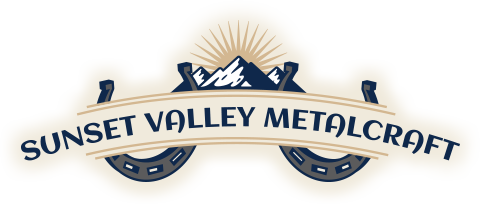Providing a safe and comfortable home for your horses is paramount, and their stalls are at the heart of that care. A well-designed stall not only offers shelter but also promotes your horse’s well-being and makes daily management easier.
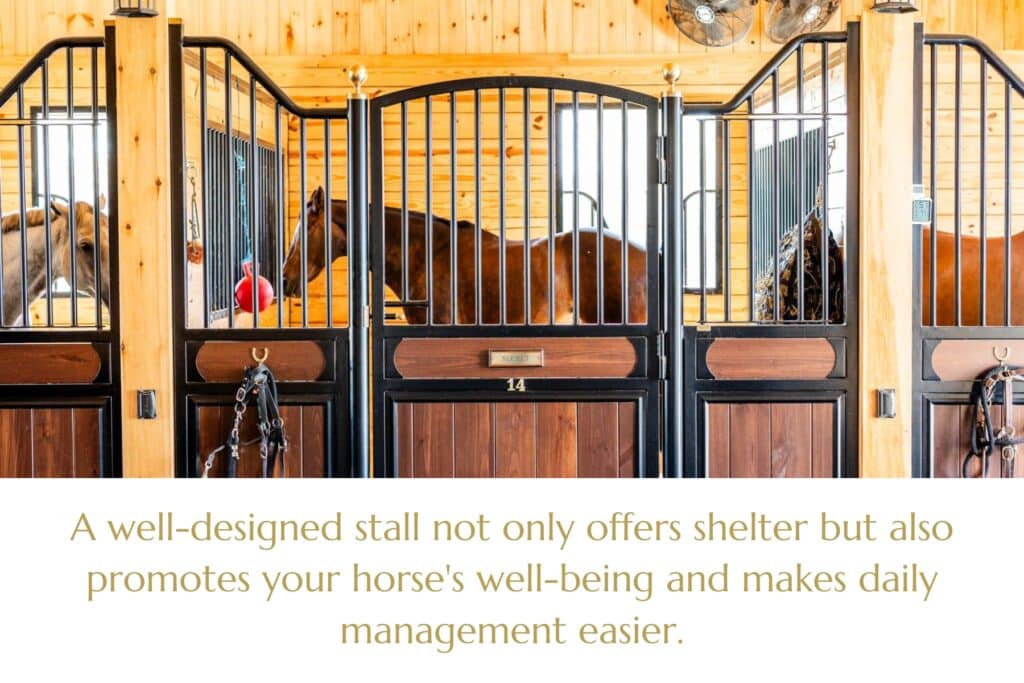
Choosing the right stall type, materials, and features is a crucial decision for any horse owner.
At Sunset Valley Metalcraft, we understand horses’ unique needs and the importance of quality craftsmanship. We specialize in creating custom metal horse stalls that blend durability, functionality, and aesthetic appeal. This FAQ post will answer common questions about horse stalls and offer valuable insights to help you make informed choices for your equine companions.
Ready to dive in?
Let’s do this!
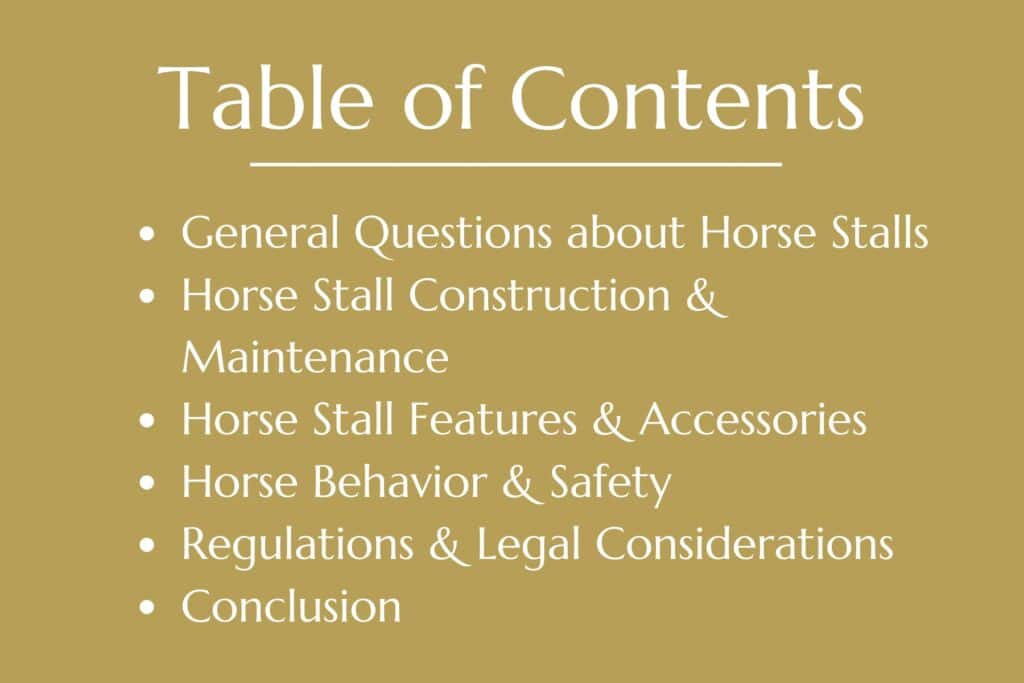
General Questions about Horse Stalls
What are the standard horse stall sizes?
While there’s no single “official” standard, the most common size for a horse stall is 12 feet by 12 feet. This provides adequate space for most horses to move around comfortably, lie down, and stand up without feeling cramped. Larger breeds or horses that are more active may benefit from a larger stall, such as 14 feet by 14 feet or even larger. Pony stalls can be slightly smaller, typically around 10 feet by 10 feet. It’s always best to consult with an experienced equestrian professional or barn builder to determine the ideal stall size for your specific horses and needs.
How much does it cost to build/buy horse stalls?
The cost of horse stalls can vary significantly based on several factors, including the materials used, the size of the stalls, the complexity of the design, and whether you’re building them yourself, hiring someone else to build them, or purchasing pre-fabricated stalls.
DIY stalls can be less expensive if you have the necessary skills and tools, but you’ll need to factor in the cost of materials, hardware, and your time. Pre-fabricated stalls offer convenience and often higher quality but come with a higher price tag. Expect to pay anywhere from a few hundred dollars for basic DIY stalls to several thousand dollars per stall for high-end, custom-built options. Getting quotes from multiple suppliers and contractors is essential for budgeting purposes.
What are the different types of horse stalls?
There are several common types of horse stalls, each with its own advantages and disadvantages:
- Box stalls: These are the most common type, offering a fully enclosed space for the horse. They provide the most freedom of movement and are generally considered the safest option.
- Tie stalls: These stalls confine the horse to a smaller area, typically with a halter and lead rope tied to a manger or wall. They are less expensive to build but offer limited movement and can be stressful for some horses. They are generally not recommended for full-time stabling.
- Shed stalls: These stalls are open on one side, typically facing an outdoor area. They offer good ventilation and allow horses to see their surroundings, but they provide less protection from the elements.
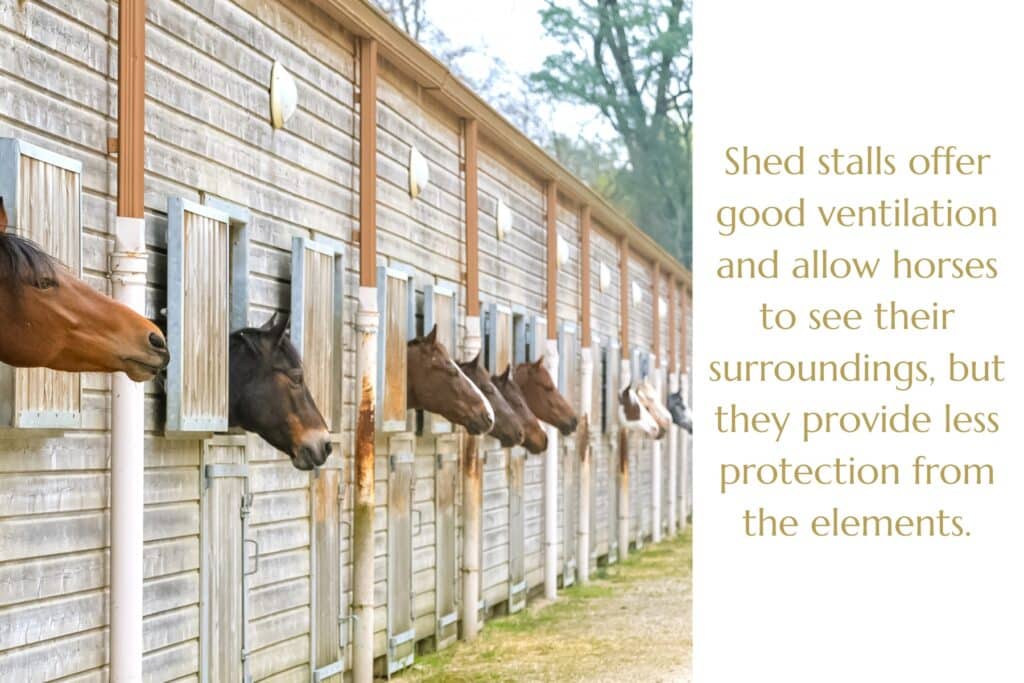
- Run-in sheds: Run-in sheds look similar to shed stalls but aren’t always laid out with individual stalls. They provide shelter and allow horses to move freely in and out. They are a good option for horses that spend a significant amount of time outdoors.
What materials are best for horse stalls?
The best materials for horse stalls combine durability, safety, and ease of maintenance. Common options include:
- Wood: Wood is a classic choice, offering a natural look and some insulation. However, it can be susceptible to chewing, rot, and insect damage. Hardwoods like oak are more durable but also more expensive.
- Metal: Metal stalls, typically made of steel or aluminum, are strong, durable, and easy to clean. However, they can be noisy and offer less insulation than wood. Powder-coated finishes can improve durability and aesthetics.
- Combination: Many stalls utilize a combination of wood and metal, with wood for the framework and metal for the stall fronts or grilles. This approach can offer a good balance of strength, aesthetics, and affordability.
How much space does a horse need in a stall?
As mentioned earlier, 12 feet by 12 feet is generally considered the minimum size for a horse stall. Larger breeds, active horses, or horses that spend a lot of time in their stalls will benefit from more space. The stall should be large enough for the horse to turn around comfortably, lie down without feeling cramped, and stand up without hitting its head on the ceiling.
How do I choose the right horse stall for my horse?
Choosing the right horse stall depends on several factors, including the size and breed of your horse, their temperament, how much time they spend in the stall, your budget, and your aesthetic preferences. Consider the pros and cons of different stall types and materials, and consult with experienced equestrian professionals or barn builders for guidance.
What are the benefits of different stall types?
Each stall type offers unique benefits:
- Box stalls: Maximum freedom of movement, safety, and comfort.
- Tie stalls: Lower cost, but limited movement and potential stress for horses.
- Shed stalls: Good ventilation, natural environment, but less protection from weather.
- Run-in sheds: Freedom of movement, natural environment, but less control over the horse.
Choosing the right stall type is crucial for your horse’s well-being and your peace of mind.
Stall Construction & Maintenance
How do I build my own horse stalls?
Building your own horse stalls can be a rewarding project, but it requires careful planning, carpentry skills, and attention to safety. A basic stall typically involves constructing a sturdy frame, installing stall fronts (grills or solid panels), and adding a door. Consider factors like stall size, materials, ventilation, drainage, and safety latches.
Before starting your project, it’s highly recommended that you consult with experienced builders or refer to detailed plans and tutorials available online or in equestrian publications. This is a complex topic, and professional guidance is often the best approach for ensuring safety and functionality.
How often should horse stalls be cleaned?
Ideally, horse stalls should be cleaned daily, or at a minimum, every other day. Removing manure and soiled bedding regularly is crucial for maintaining hygiene, preventing the buildup of ammonia, and reducing the risk of health problems for your horse.
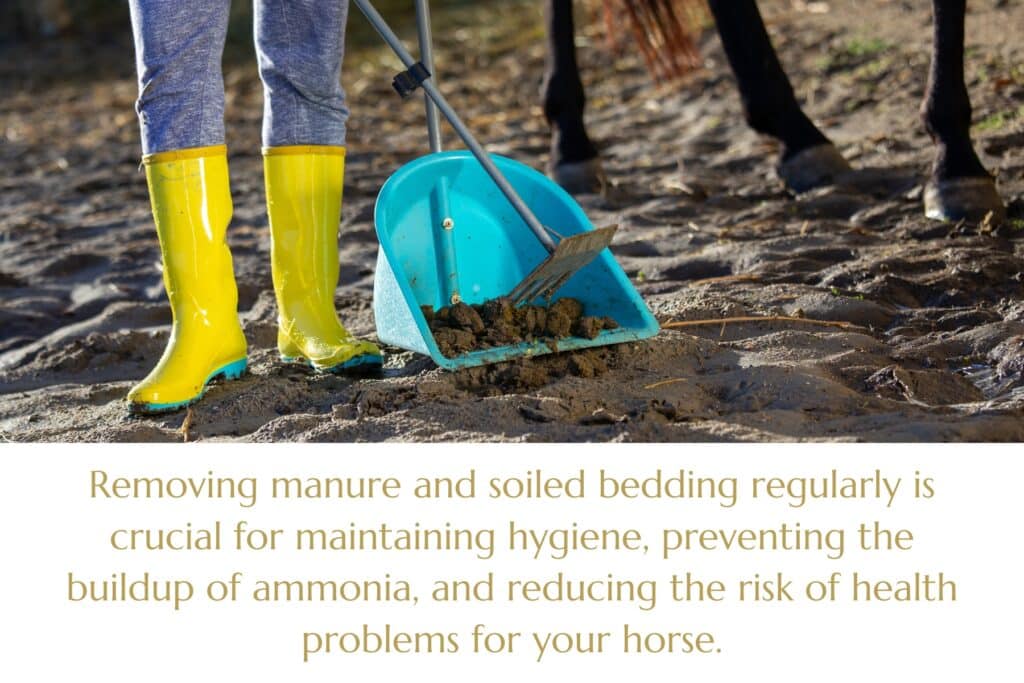
More frequent cleaning may be necessary depending on the individual horse, the type of bedding used, and the weather conditions.
How do I maintain wood horse stalls?
Maintaining wood horse stalls involves regular inspection and preventative care. Check for signs of chewing, rot, cracks, or loose hardware. Repair or replace damaged wood promptly to prevent further deterioration and potential injuries. Applying a non-toxic wood preservative or sealant can help protect the wood from moisture and extend its lifespan. Ensure proper drainage to prevent rot.
How do I maintain metal horse stalls?
Metal horse stalls are generally easier to maintain than wood stalls. Regularly check for rust, loose connections, or sharp edges. Clean the metal surfaces with a mild detergent and water as needed. For powder-coated stalls, touch up any scratches or chips in the coating to prevent rust. Lubricate hinges and latches as needed to ensure smooth operation.
What are some common horse stall problems, and how do I fix them?
- Chewing: Horses may chew on wood stalls out of boredom, curiosity, or nutritional deficiencies. Provide plenty of hay and forage, offer chew toys, and consider using chew deterrents or metal guards on vulnerable areas.
- Kicking: Kicking at stall walls can be a sign of frustration, anxiety, or discomfort. Ensure the stall is adequately sized and provide sufficient turnout time. Investigate any underlying health issues or behavioral problems. Padding the stall walls can help minimize injury.
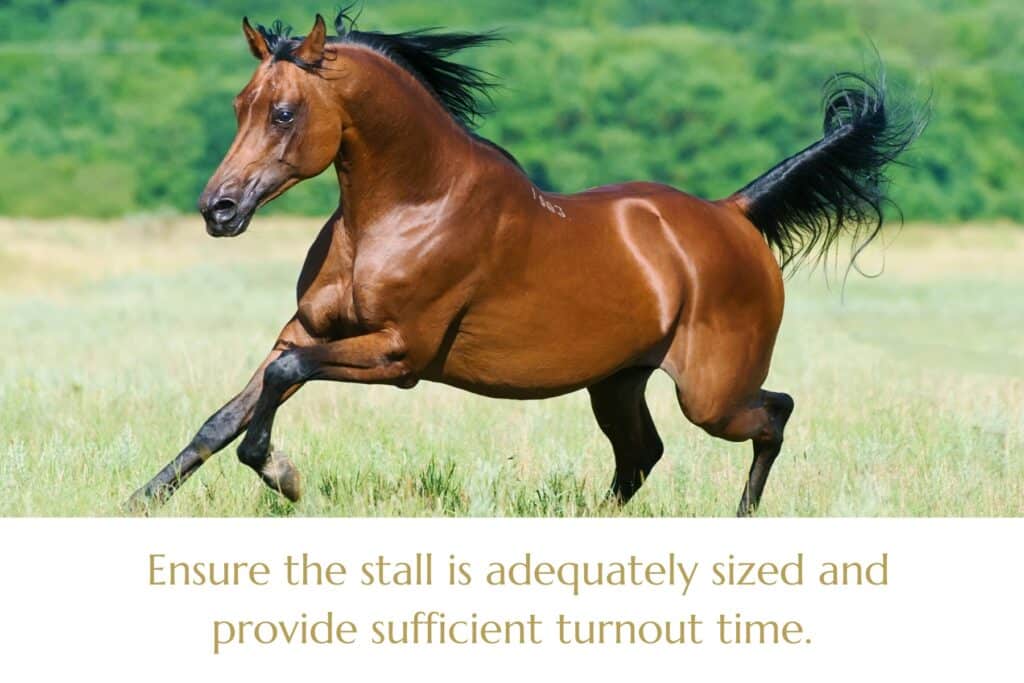
- Weaving/Pacing: These repetitive behaviors can indicate stress or boredom. Provide ample turnout, social interaction, and mental stimulation. Consult with an equine behaviorist if the behavior persists.
How do I prevent my horse from chewing on their stall?
Preventing stall chewing involves addressing the underlying causes and providing alternatives.
- Adequate Forage: Ensure your horse has constant access to hay or pasture to satisfy their natural chewing instincts.
- Chew Toys: Offer safe and appropriate chew toys specifically designed for horses.
- Salt and Mineral Blocks: Provide access to salt and mineral blocks to address any potential nutritional deficiencies.
- Chew Deterrents: Apply non-toxic chew deterrents to vulnerable areas of the stall.
- Metal Guards: Install metal guards or strips over areas that are frequently chewed.
- Increased Turnout: More time spent outside the stall can reduce boredom and chewing behavior.
- Social Interaction: Horses are social animals. Providing opportunities for interaction with other horses can reduce stress and boredom.
Stall Features & Accessories
What are the essential features of a good horse stall?
A good horse stall prioritizes the horse’s safety, comfort, and well-being. Essential features include:
- Proper Ventilation: Adequate airflow is crucial for removing ammonia fumes and preventing respiratory problems. Stalls should have sufficient ventilation without creating drafts.
- Safe Latches: Latches and closures should be easy for humans to operate but secure enough to prevent horses from escaping. They should be free of sharp edges or protrusions that could cause injury.
- Adequate Drainage: Proper drainage is essential for keeping the stall dry and preventing the buildup of moisture, which can lead to hoof problems and other health issues. The stall floor should be sloped slightly to allow for drainage.
- Appropriate Size: The stall should be large enough for the horse to move around comfortably, lie down, and stand up without feeling cramped.
- Smooth Surfaces: To prevent injuries, interior stall surfaces should be smooth. Avoid sharp edges, splinters, or protruding hardware.
- Sturdy Construction: The stall should be built with strong, durable materials that can withstand the weight and activity of a horse.
- Easy Access: The stall door should be wide enough to allow for easy entry and exit for both the horse and the handler.
What are some useful horse stall accessories?
Several accessories that enhance the functionality and comfort of a horse stall and are essential for a happy and healthy horse include:
- Hay Feeders: Hay feeders help to keep hay off the ground, reducing waste and preventing contamination. They also help to regulate the horse’s hay consumption.
- Water Buckets/Automatic Waterers: It is essential to provide a constant supply of fresh, clean water. Automatic waterers can simplify this task.
- Salt Licks: Salt licks provide horses with essential electrolytes and minerals.
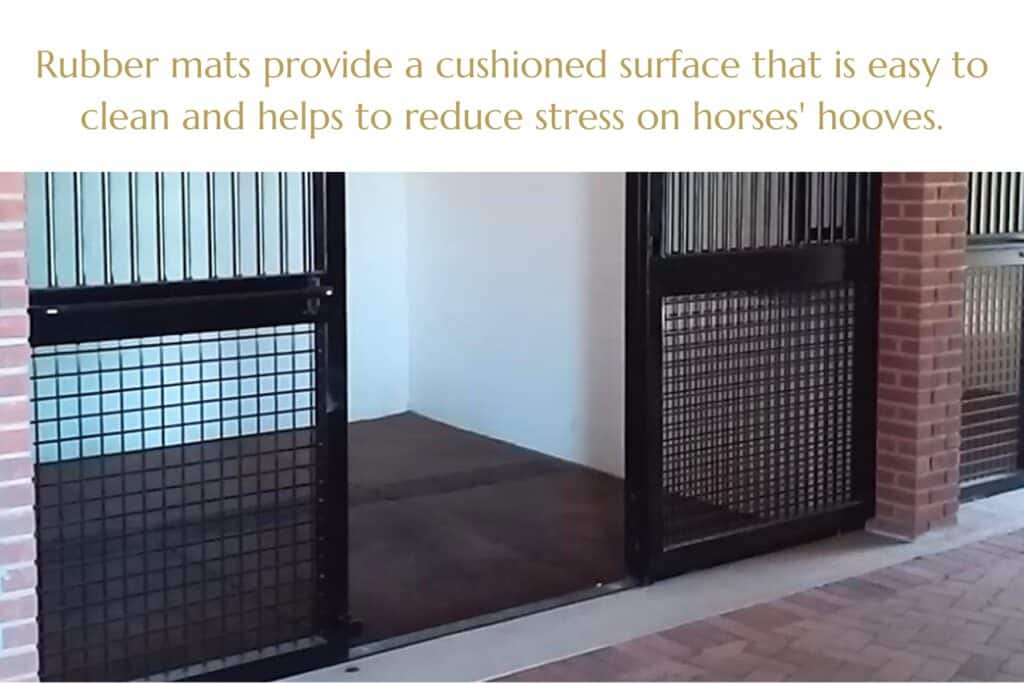
- Mineral Feeders: Similar to salt licks, mineral feeders offer a balanced supply of essential minerals.
- Blanket Bars: These provide a convenient place to hang blankets and other horse clothing.
- First-Aid Kit: Keeping a well-stocked first-aid kit readily available in the barn is essential for addressing minor injuries.
- Fly Control: Fly traps, sprays, or other fly control methods can help to create a more comfortable environment for your horse.
What type of flooring is best for horse stalls?
The best type of flooring for horse stalls combines comfort, durability, and ease of cleaning. Common options include:
- Dirt: Dirt is a natural and relatively inexpensive option, but it can be difficult to maintain and can become muddy or dusty.
- Clay: Clay is another natural option that offers good drainage but can become slippery when wet.
- Concrete: Concrete is durable and easy to clean, but it can be hard on horses’ hooves and cold in colder climates. It’s often used as a base with mats on top.
- Rubber Mats: Rubber mats provide a cushioned surface that is easy to clean and helps to reduce stress on horses’ hooves. They are often placed over concrete or other hard surfaces.

- Wood Shavings/Bedding: While not technically flooring, deep bedding is essential for providing cushioning and warmth, and absorbing urine.
How do I provide adequate ventilation in a horse stall?
Adequate ventilation is crucial for maintaining a healthy environment for your horse. Here are some ways to improve ventilation:
- Open Doors and Windows: When weather permits, opening doors and windows significantly improves airflow.
- High Ceilings: High ceilings allow for better air circulation.
- Roof Vents: Roof vents allow warm, stale air to escape.
- Fans: Fans help circulate air, but be sure to position them safely so they are not a hazard to the horses.
- Proper Barn Design: The overall design of the barn should promote good airflow.
What kind of lighting is appropriate for horse stalls?
Adequate lighting is essential for both the horse’s well-being and the safety of the handler.
- Natural Light: Natural light is the best option for horses. Barns should be designed to maximize natural light.
- Artificial Lighting: Artificial lighting should supplement natural light, especially during the darker months. LED lights are energy-efficient and provide bright, even illumination.
- Safety Lighting: Ensure that there is adequate lighting in all areas of the barn, including stalls, aisles, and storage areas. Outdoor lighting is also important for safety.
- Timer Systems: Using timers for artificial lighting can help to regulate the horse’s natural day-night cycle.
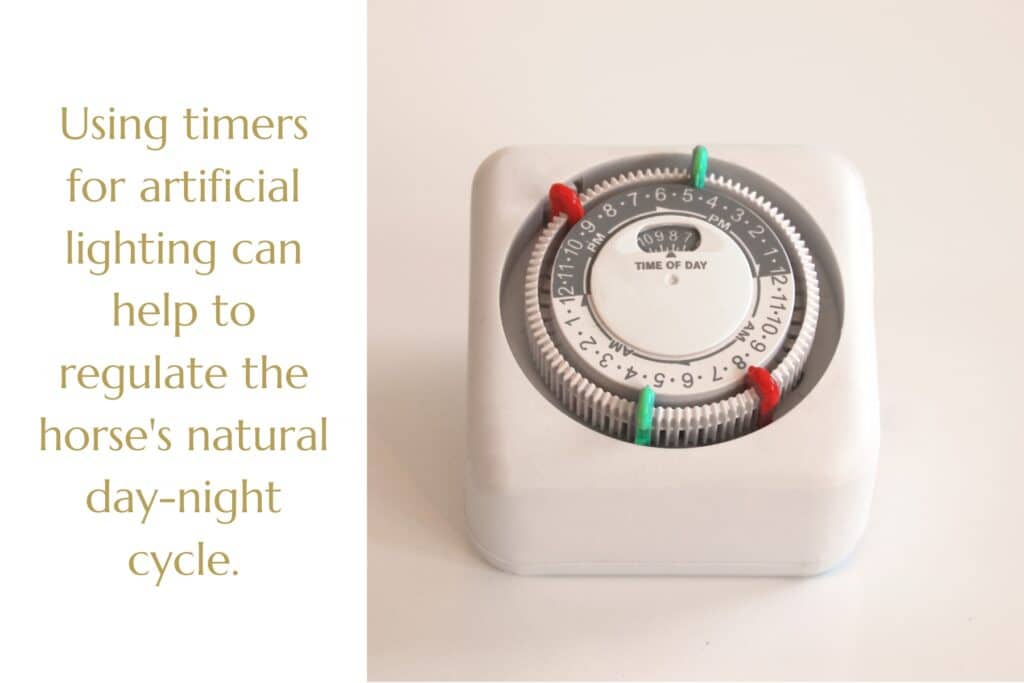
Horse Behavior & Safety
How do I introduce my horse to a new stall?
Introducing a horse to a new stall should be done gradually and carefully. Here’s an approach we suggest:
- First, introduce the horse to the barn environment. Let the horse explore the barn and get used to the sights, sounds, and smells.
- Show the horse the new stall: Lead the horse to the stall and allow them to sniff and investigate it.
- Make the stall inviting: Provide fresh bedding, hay, and water in the stall.
- Supervise the first few visits: Observe the horse’s behavior closely during their initial visits to the stall.
- Start with short periods: Gradually increase the amount of time the horse spends in the stall.
- Be patient and reassuring: Offer the horse reassurance and positive reinforcement during the introduction process.
- Monitor for signs of stress: Watch for signs of anxiety or discomfort, such as pawing, kicking, or excessive vocalization. If the horse seems overly stressed, slow down the introduction process.
How can I prevent my horse from developing bad habits in their stall?
Preventing bad habits in the stall requires a combination of management practices and addressing the horse’s needs:
- Provide adequate turnout: Sufficient turnout time allows horses to exercise, socialize, and express natural behaviors, reducing boredom and frustration in the stall.
- Ensure proper stall size: A stall that is too small can lead to anxiety and the development of undesirable behaviors.
- Offer mental stimulation: Provide toys, puzzle feeders, or other forms of mental enrichment to keep the horse engaged and prevent boredom.
- Maintain a regular feeding schedule: Consistent feeding times can help to reduce anxiety and prevent behaviors associated with food anticipation.
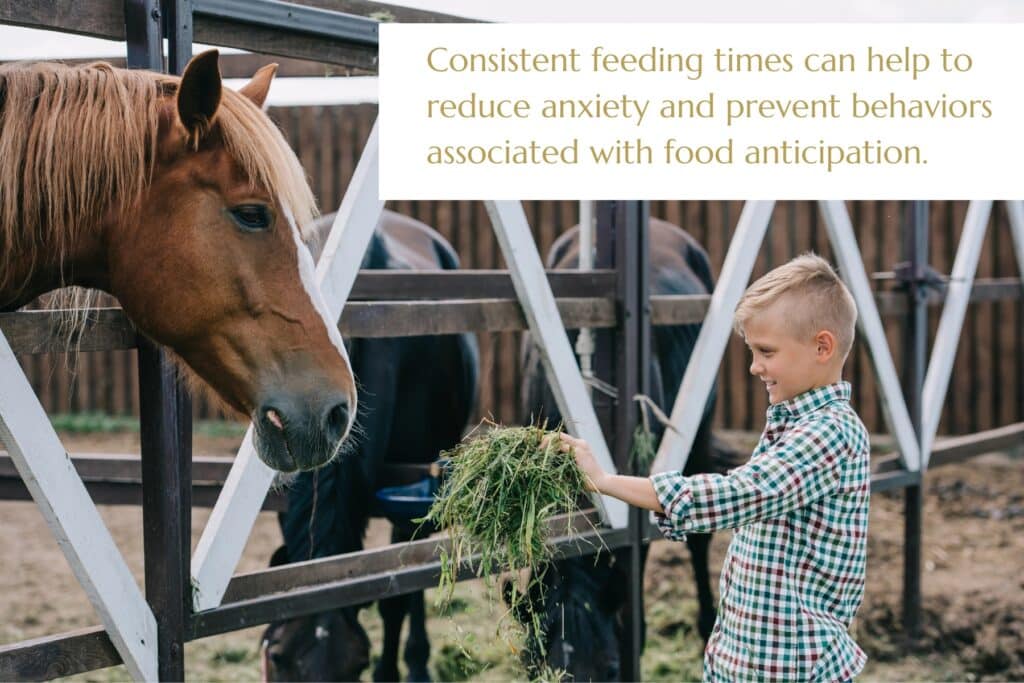
- Provide social interaction: Horses are social animals. Allowing them to interact with other horses can reduce stress and boredom.
- Address underlying health issues: Sometimes, stall vices can be a sign of pain or discomfort. Consult with a veterinarian to rule out any medical problems.
- Be consistent with training: Consistent training and handling help to establish clear boundaries and prevent the development of bad habits.
What are the signs of stress in a stalled horse?
Recognizing the signs of stress in a stalled horse is crucial for addressing the issue and preventing it from escalating. Common signs of stress include:
- Pawing or kicking at the stall walls: This can be a sign of frustration or anxiety.
- Weaving or pacing: These repetitive behaviors can indicate boredom or stress.
- Head shaking or tossing: This can be a sign of frustration or discomfort.
- Excessive vocalization: Frequent whinnying or nickering can indicate stress or loneliness.

- Loss of appetite: A stressed horse may lose interest in food.
- Changes in manure consistency: Stress can affect a horse’s digestive system.
- Increased vigilance: A stressed horse may be more alert and reactive to its surroundings.
How can I make my horse’s stall more comfortable?
Creating a comfortable stall environment is essential for the horse’s well-being. It’s more than just a roof and four walls; it’s a sanctuary. Here are some ways to improve stall comfort:
- Provide deep bedding. Deep bedding provides cushioning and warmth and helps absorb urine, promoting a dry and comfortable resting area.
- Ensure adequate ventilation: Proper airflow is crucial for preventing the buildup of ammonia fumes and maintaining a healthy environment. A stuffy, poorly ventilated stall is a breeding ground for illness.
- Offer fresh, clean water: Horses should have access to a constant supply of fresh, clean water. Just like us, they need proper hydration.
- Provide plenty of hay: Hay should be available throughout the day to satisfy the horse’s chewing instincts and prevent boredom. There are few sounds as rewarding as the rhythmic, contented munching of a horse enjoying its hay.
- Offer salt and mineral supplements: These are essential for maintaining the horse’s electrolyte balance and overall health.
- Provide mental stimulation: Toys, puzzle feeders, and other forms of enrichment help to keep the horse engaged and prevent boredom. A bored horse can become a destructive horse.
- Maintain a regular routine: A consistent routine helps to reduce anxiety and create a sense of security for the horse. They are creatures of habit, after all.
What are some common safety concerns with horse stalls?
You will want to consider several safety concerns when designing and maintaining your horse stalls:
- Sharp edges or protrusions: These can cause injuries to horses. All surfaces should be smooth and free of sharp edges.
- Loose hardware: Loose screws, bolts, or other hardware can become a hazard. Regularly inspect and tighten all connections.
- Faulty latches: Latches should be secure enough to prevent horses from escaping but easy for humans to operate.
- Inadequate ventilation: Poor ventilation can lead to the buildup of ammonia fumes, which can cause respiratory problems.
- Fire hazards: Hay, straw, and other bedding materials are highly flammable. Smoking should be prohibited in or near the barn.
- Electrical hazards: All electrical wiring should be properly installed and maintained to prevent shocks or fires.
- Pest control: Rodents and insects can create unsanitary conditions and pose a health risk to horses.
Regulations & Legal Considerations
Are there any building codes or regulations I need to consider when building horse stalls?
Yes, depending on your location, there may be building codes and regulations that you need to consider when building horse stalls. These regulations vary significantly from state to state, county to county, and even municipality to municipality. They cover aspects like:
- Zoning regulations: These regulations may dictate where you are allowed to build horse stalls on your property.
- Building permits: You may need to obtain building permits before starting construction.
- Fire codes: Fire codes may dictate specific requirements for barn construction, including materials, exits, and fire suppression systems.
- Setback requirements: These regulations may specify how far your barn must be set back from property lines.
- Environmental regulations: Depending on your location, there may be regulations regarding manure management and runoff.
Before you begin construction, contact your local building department or planning office to determine the specific regulations for your project.

Failure to comply with these regulations can result in fines, delays, or even the need to tear down your structure.
Are there any legal considerations regarding horse stall size or safety?
While there are generally no specific legal requirements for stall size in most areas (unless related to animal welfare in certain jurisdictions), ensuring the safety of your horse stalls is paramount and can have legal implications. If an injury occurs due to a negligently maintained or constructed stall, you could be held liable. Therefore, it’s essential to:
- Prioritize safety: Build stalls that are structurally sound, free of hazards, and appropriately sized for the horses they will house.
- Consult with professionals: If you are unsure about any aspect of stall construction or safety, consult with experienced builders or equine professionals.
- Carry insurance: Having appropriate liability insurance is essential for any horse owner.
It’s always wise to consult with a legal professional specializing in equine law to understand any specific legal considerations related to horse stalls in your region. Animal welfare laws might also apply, particularly regarding minimum space requirements, which, if not met, could be considered a form of animal cruelty.
Conclusion
Like you, most horse owners want to create a safe, comfortable, and functional environment for their horses. This FAQ post has covered many common questions about horse stalls, from size and materials to construction, maintenance, and safety. Yet, if we haven’t addressed something you’re really wondering about, don’t hesitate to reach out.
Remember – careful planning, attention to detail, and a focus on your horses’ well-being are essential for creating the ideal stabling situation.
At Sunset Valley Metalcraft, we understand the importance of quality craftsmanship and durable materials in horse stalls. We specialize in creating custom metal stalls tailored to your specific needs and preferences. Our experienced team can work with you to design and build stalls that are not only beautiful and functional but also safe and long-lasting.
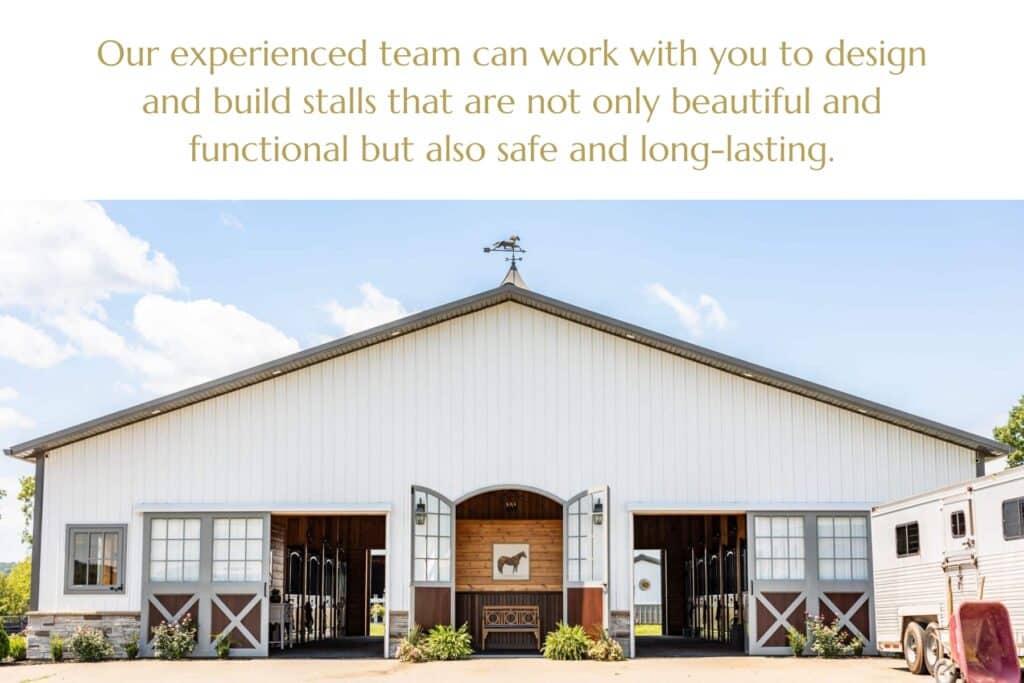
We encourage you to contact us for a free consultation. Let us help you create the perfect home for your horses, a space where they can thrive and you can have peace of mind. Call us today to discuss your project and discover the possibilities that await you with Sunset Valley Metalcraft.
If you’re looking for more tips and ideas on providing quality horse stalls for your horses, check out these other posts on our blog:


